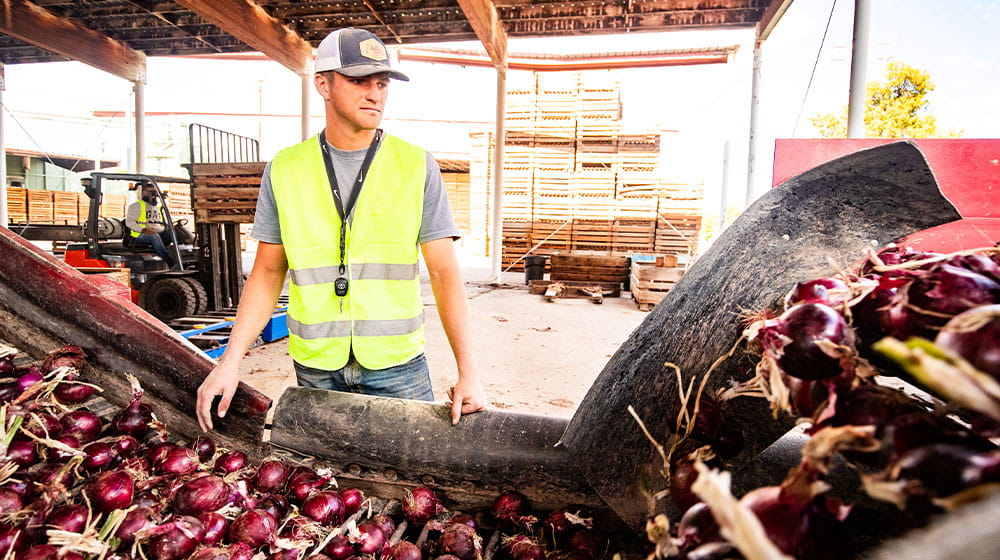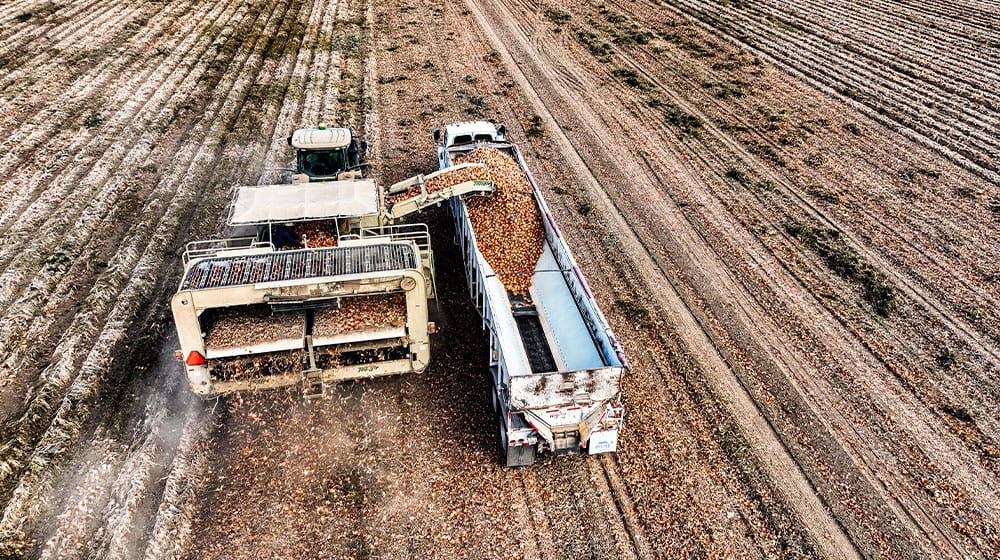Workers on Nick and Berenise Gomeza’s farm near Ontario, Ore., race against Mother Nature to harvest more than 40 million pounds of red and yellow onions.
A wet spring delayed 2023 planting by two weeks and harvest didn’t begin until late September. With average first frost typically landing in mid-October and several weeks needed to bring in 1,000 acres of onions, normal harvest stress was amplified. If it weren’t for the 20 foreign workers the Gomezas hired through the federal H-2A temporary agricultural labor program, Berenise Gomeza says there’s a chance many vegetables would have frozen and rotted in the fields.
“I can’t find anyone locally to work [in the fields],” says Gomeza, despite offering pay exceeding Oregon’s minimum wage of $14.20 per hour. She knows harvesting onions isn’t easy. Workers stand on noisy, dusty harvesters, quickly pulling off onion tops as the vegetables are loaded into trucks. Workdays can be as long as 16 hours. Processing onions is hard, fast-paced work, too, but it all must be done.
“We only have so much time to get the crop in or we’ll lose it,” Gomeza says. “If it weren’t for H-2A workers, we couldn’t grow our business.”
Help wanted on the farm
Labor shortages plague agriculture. The U.S. Department of Labor Statistics projects about 142,000 job openings on average every year through 2032 in farming, fishing and forestry.
Finding ag workers will likely get even tougher for many reasons, says David Magana, senior horticulture analyst with Rabobank. Key factors include skilled farm workers aging out without willing replacements, smaller family sizes in the U.S. and Mexico, and stiff competition from construction and other industries.
H-2A program by the numbers (fiscal year 2023)
- Positions requested: 389,908
- Positions certified: 378,513
- Total applications processed: 20,881
- Applications processed: 98.2%
Source: U.S. Department of Labor
“There are fewer migrant workers now with the experience and willingness to work in agriculture,” Magana says.
The H-2A program is one answer to the farm labor shortage. The program, primarily administered by the U.S. Department of Labor (DOL), allows employers who anticipate a shortage of domestic workers to temporarily hire nonimmigrant foreign workers for less than a year. Jobs are generally seasonal and tied to an event or pattern, such as harvest or planting. Guest workers return home at the close of the season, but many return to the U.S. year after year, often to the same employer.
Use of the program by farmers, cooperatives and ag businesses has skyrocketed. The DOL certified more than 378,000 temporary jobs in fiscal year 2023, seven times the number in 2005. About 80% of certified job requests result in visas being issued to workers to enter the U.S., data shows.
Investing in ag workers
Using the program isn’t cheap or easy for employers. Filing and visa fees are about $1,000 per worker, according to the U.S. Department of Agriculture (USDA). The paperwork is intensive and time-consuming and often means hiring a third party specializing in H-2A visa assistance, which can cost several thousand dollars per worker.
Employers must provide transportation for workers to and from their home countries and while working in the U.S. They must also provide housing and guarantee full-time work — at least 35 hours per week — at a mandated minimum wage of the average hourly pay for field and livestock workers in each state that exceeds the minimum wage, but doesn’t adversely affect local workers. In Oregon, the 2023 pay rate was $17.97 per hour. In some states, overtime pay is also mandated.
“The H-2A program is an alternative to meet the demand for ag workers,” Magana says. “The H-2A program increases the cost of labor for farmers. Some farmers who use it say, ‘I have to pay 15% more [for labor], but productivity has gone up 20%.’ ”
Team players
The Gomezas operate both N.J. Gomeza Farms and Riverfront Produce, located across the Oregon border and Snake River in Payette, Idaho. The farming operation started in 2005, producing a few hundred acres of onions. Besides onions, the operation grows 1,400 acres of winter wheat and added 600 acres of potatoes two years ago. A packing facility was acquired in 2011. The vegetables are shipped throughout North America to grocery stores, restaurants and food processors.
H-2A workers have been an integral part of the businesses for five years. Guest workers help plant, irrigate, apply crop protection products and harvest crops. Some workers are hired for a couple of months, while others stay the entire season. The Gomezas hired 28 men through the H-2A program in 2023 — about half of their workforce. One was from South Africa and the rest came from Mexico.
“While other businesses have struggled [to find help], we have continued to grow by adding potatoes to our program,” Gomeza says. “[H-2A] has benefited us. It’s expensive, but the guys are dependable and work hard.”
Steve Mendiola, general manager of Farmers Supply Cooperative based in Ontario, says the local labor crunch is real. The co-op, which supplies fertilizer, crop protection inputs and more to the Gomezas, is also considering using the H-2A program.
“We’re always looking for help. Several local farmers and packing houses use the program,” Mendiola says. “The Gomezas have fine-tuned using it.” “There’s a lot of paperwork and state and federal regulations to follow,” says Gomeza, “but once you get it down, it’s a pretty easy process.” Still, with a young family and a business to run, she hires a firm to help.

Employee-focused
Continuity and experience are critical to making the H-2A program pay, Gomeza says. That means treating workers well to ensure a core group returns every year, which reduces training needs and boosts productivity. As a result, she says, “We’re raising more crops with less people.”
The Gomezas purchased four furnished double-wide manufactured homes and one house for the operation’s H-2A workers. Each home has air conditioning, a washer and dryer, and a yard.
Gomeza inspects the homes each week and rewards workers with the cleanest residence with free groceries. The farm provides food during the workday, trucks and vans for transportation and cellphones to enhance communication, allow workers to record their work hours and let them communicate with family and friends.
For farmers thinking about using the H-2A program, Gomeza advises following the Golden Rule.
“If you expect your workers to do well, you need to do well for them,” she says. “They are leaving their families for 10 to 12 weeks at a time, sometimes up to 10 months. It’s only right to make sure they are treated well and rewarded.”
C.P. “Soap” Venter, 22, sought out H-2A employment for the first time in 2023 and was foreman of the produce unloading crew for the Gomezas, working from mid-September to mid-December.
At home near Jeffreys Bay, South Africa, Venter works on a cattle and sheep ranch, earning the equivalent of $15 in U.S. currency per day. He says he’s used to working long days and enjoys the higher income he receives working for the Gomezas.
“We’re here to chase hours, make money and get the job done,” he says, adding he hopes to return to the Gomeza farm in 2024. “I want to impress the boss to come back and do it better every year.”
H-2A workers help meet co-op labor needs
The labor crunch is also being felt by cooperatives and the H-2A guest worker program is helping to fill those gaps.
The CHS ag retail location based in Devils Lake, N.D., first used the H-2A program in 2022, hiring three workers from South Africa. The number doubled in 2023 and is likely to reach 10 workers in 2024.
“It’s increasingly difficult to hire part-time employees. Due to the seasonal nature of our business, we decided this would be our best option to fill hiring gaps,” says Jason Edwards, the location’s senior director of operations. “The program has allowed us to meet our customers’ expectations while giving our facilities and employees the help they need.”
On site from March through November, the guest workers prepared equipment and facilities for the growing season, handled grain and more. An added bonus: “Our employees made lasting relationships with the guest workers,” says Edwards.
In the Pacific Northwest, cooperative teams and customers also benefit from the H-2A program. Five workers were based in Langdon, Wash., for the 2023 growing season, moving and applying fertilizer across the region as needs shifted. Jim Crockett, senior operations manager at Langdon, reports one worker even acquired a commercial driver’s license so he could move fertilizer to farms and custom application rigs.
Check out the full Winter 2024 C magazine with this article and more.




